第二十章 多线程

20.2创建线程
20.2.1继承Thread类
Thread类是Java.lang包中的一个类,从这个类中实例化的对象代表线程,程序员启动一个新线程需要建议Thread实例。
public class ThreadTest extedns Thread{}
run方法格式:
public void run(){}
20.1让线程循环打印1-10
?
- public class ThreadTest extends Thread {
- ?? ?public void run() {
- ?? ??? ?for (int i = 1; i <= 10; i++) {
- ?? ??? ??? ?System.out.print(i + " ");
- ?? ??? ?}
- ?? ?}
- ?
- ?? ?public static void main(String[] args) {
- ?? ??? ?ThreadTest t = new ThreadTest();
- ?? ??? ?t.start();
- ?? ?}
- }
//20.1
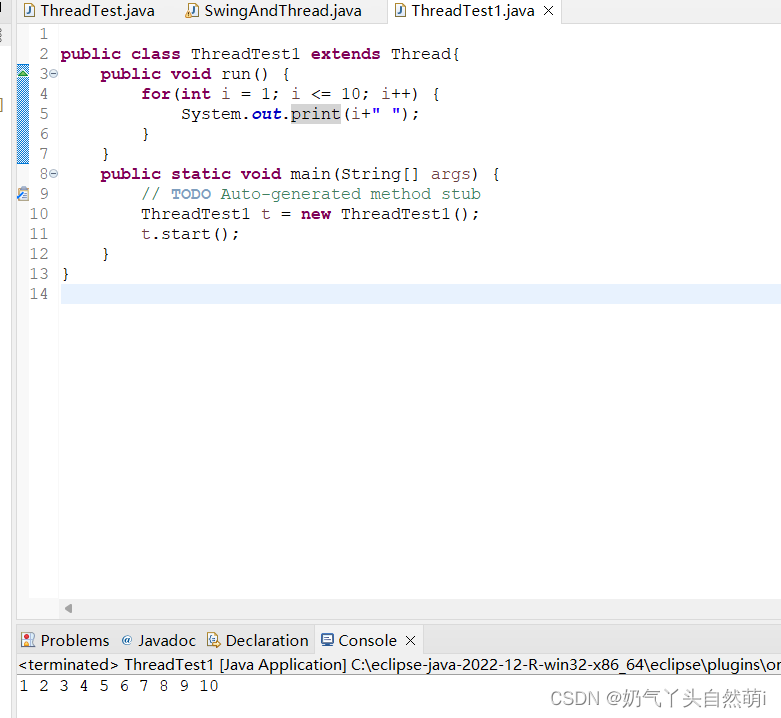

20.2.2实现Runnable类
public class Tread extends Object implements Runnable
20.2让窗口的图标移动
- import java.awt.Container;
- import javax.swing.*;
- //20.2
- public class SwingAndThread extends JFrame {
- ?? ?int count = 0; // 图标横坐标
- ?
- ?? ?public SwingAndThread() {
- ?? ??? ?setBounds(300, 200, 250, 100); // 绝对定位窗体大小与位置
- ?? ??? ?Container container = getContentPane();// 主容器
- ?? ??? ?container.setLayout(null); // 使窗体不使用任何布局管理器
- ?
- ?? ??? ?Icon icon = new ImageIcon("src/1.gif"); // 图标对象
- ?? ??? ?JLabel jl = new JLabel(icon);// 显示图标的标签
- ?? ??? ?jl.setBounds(10, 10, 200, 50); // 设置标签的位置与大小
- ?? ??? ?Thread t = new Thread() { // 定义匿名线程对象
- ?? ??? ??? ?public void run() {
- ?? ??? ??? ??? ?while (true) {
- ?? ??? ??? ??? ??? ?jl.setBounds(count, 10, 200, 50); // 将标签的横坐标用变量表示
- ?? ??? ??? ??? ??? ?try {
- ?? ??? ??? ??? ??? ??? ?Thread.sleep(500); // 使线程休眠500毫秒
- ?? ??? ??? ??? ??? ?} catch (InterruptedException e) {
- ?? ??? ??? ??? ??? ??? ?e.printStackTrace();
- ?? ??? ??? ??? ??? ?}
- ?? ??? ??? ??? ??? ?count += 4; // 使横坐标每次增加4
- ?? ??? ??? ??? ??? ?if (count >= 200) {
- ?? ??? ??? ??? ??? ??? ?// 当图标到达标签的最右边时,使其回到标签最左边
- ?? ??? ??? ??? ??? ??? ?count = 10;
- ?? ??? ??? ??? ??? ?}
- ?? ??? ??? ??? ?}
- ?? ??? ??? ?}
- ?? ??? ?};
- ?? ??? ?t.start(); // 启动线程
- ?? ??? ?container.add(jl); // 将标签添加到容器中
- ?? ??? ?setVisible(true); // 使窗体可见
- ?? ??? ?// 设置窗体的关闭方式
- ?? ??? ?setDefaultCloseOperation(EXIT_ON_CLOSE);
- ?? ?}
- ?
- ?? ?public static void main(String[] args) {
- ?? ??? ?new SwingAndThread(); // 实例化一个SwingAndThread对象
- ?? ?}
- }
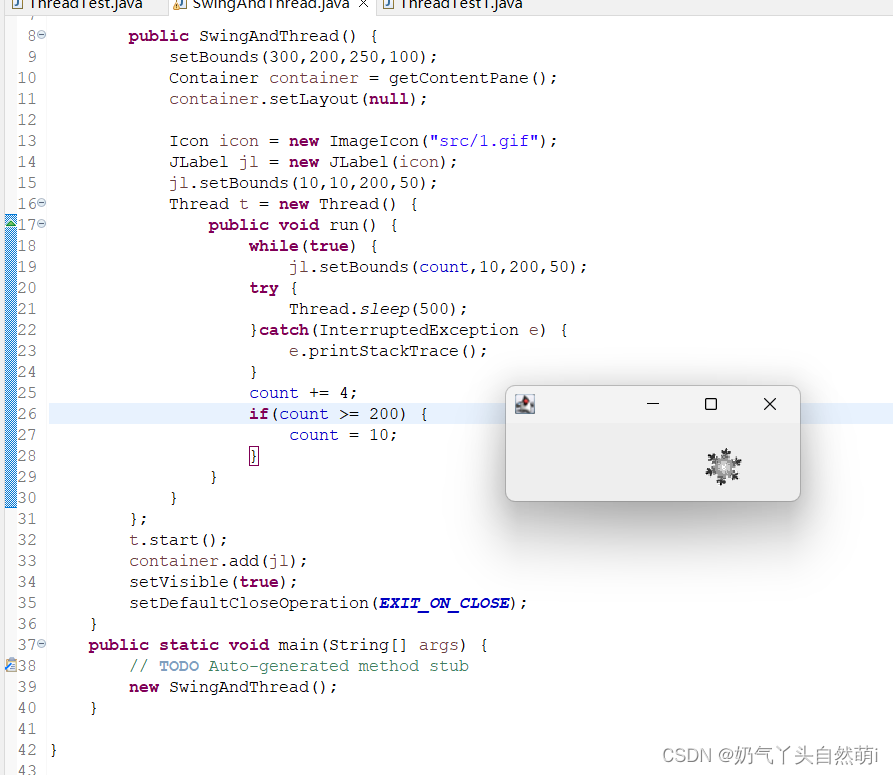
20.3线程的生命周期
20.4操作线程的方法
20.4.1线程的休眠
sleep方法 ?该时间以毫秒为单位
try{
Thread.sleep(2000);
}catch(InterruptedException e){
e.printStackTrace();
}
20.3每0.1秒绘制一条随机颜色的线条
?
- //20.3
- import java.awt.*;
- import java.util.Random;
- import javax.swing.*;
- ?
- public class SleepMethodTest extends JFrame {
- ?? ?private static Color[] color = { Color.BLACK, Color.BLUE, Color.CYAN, Color.GREEN, Color.ORANGE, Color.YELLOW,
- ?? ??? ??? ?Color.RED, Color.PINK, Color.LIGHT_GRAY }; // 定义颜色数组
- ?? ?private static final Random rand = new Random(); // 创建随机对象
- ?
- ?? ?private static Color getC() { // 获取随机颜色值的方法
- ?? ??? ?return color[rand.nextInt(color.length)];
- ?? ?}
- ?
- ?? ?public SleepMethodTest() {
- ?? ??? ?Thread t = new Thread(new Runnable() { // 创建匿名线程对象
- ?? ??? ??? ?int x = 30; // 定义初始坐标
- ?? ??? ??? ?int y = 50;
- ?
- ?? ??? ??? ?public void run() {?
- ?? ??? ??? ??? ?while (true) { // 无限循环
- ?? ??? ??? ??? ??? ?try {
- ?? ??? ??? ??? ??? ??? ?Thread.sleep(100); // 线程休眠0.1秒
- ?? ??? ??? ??? ??? ?} catch (InterruptedException e) {
- ?? ??? ??? ??? ??? ??? ?e.printStackTrace();
- ?? ??? ??? ??? ??? ?}
- ?? ??? ??? ??? ??? ?Graphics graphics = getGraphics(); // 获取组件绘图上下文对象
- ?? ??? ??? ??? ??? ?graphics.setColor(getC()); // 设置绘图颜色
- ?? ??? ??? ??? ??? ?graphics.drawLine(x, y, 100, y++); // 绘制直线并递增垂直坐标
- ?? ??? ??? ??? ??? ?if (y >= 80) {
- ?? ??? ??? ??? ??? ??? ?y = 50;
- ?? ??? ??? ??? ??? ?}
- ?? ??? ??? ??? ?}
- ?? ??? ??? ?}
- ?? ??? ?});
- ?? ??? ?t.start(); // 启动线程
- ?? ?}
- ?
- ?? ?public static void main(String[] args) {
- ?? ??? ?init(new SleepMethodTest(), 100, 100);
- ?? ?}
- ?
- ?? ?public static void init(JFrame frame, int width, int height) { // 初始化程序界面的方法
- ?? ??? ?frame.setDefaultCloseOperation(JFrame.EXIT_ON_CLOSE);
- ?? ??? ?frame.setSize(width, height);
- ?? ??? ?frame.setVisible(true);
- ?? ?}
- }
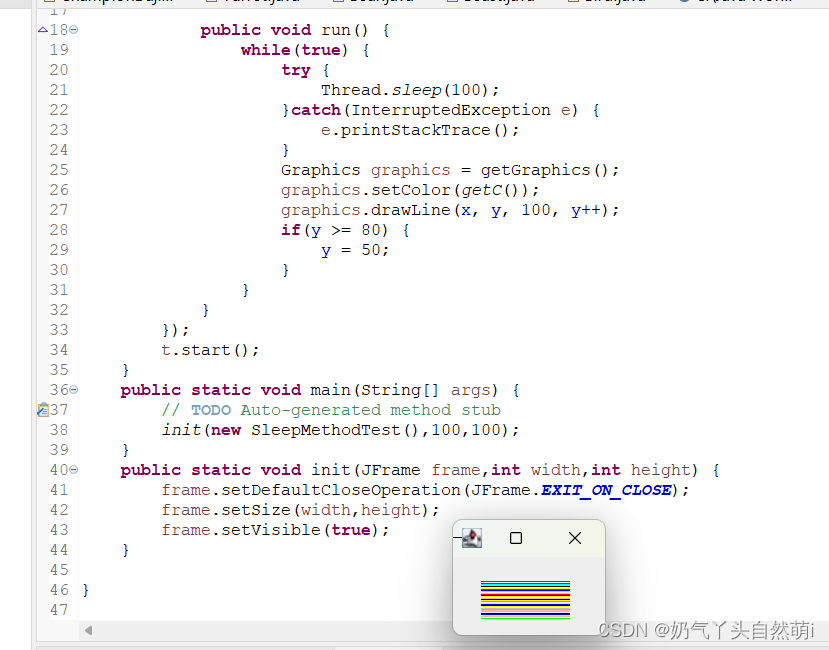
20.4.2线程的加入
当某个线程使用join()方法加入另一个线程时,另一个线程会等待该线程执行完毕后再继续执行。
20.4让进度条A等待进度条B
- //20.4
- import java.awt.BorderLayout;
- import javax.swing.*;
- ?
- public class JoinTest extends JFrame {
- ?? ?private Thread threadA; // 定义两个线程
- ?? ?private Thread threadB;
- ?? ?private JProgressBar progressBar = new JProgressBar(); // 定义两个进度条组件
- ?? ?private JProgressBar progressBar2 = new JProgressBar();
- ?
- ?? ?public static void main(String[] args) {
- ?? ??? ?JoinTest test = new JoinTest();
- ?? ??? ?test.setVisible(true);
- ?? ?}
- ?
- ?? ?public JoinTest() {
- ?? ??? ?setDefaultCloseOperation(JFrame.EXIT_ON_CLOSE);
- ?? ??? ?setBounds(200, 200, 200, 100);
- ?? ??? ?getContentPane().add(progressBar, BorderLayout.NORTH); // 将进度条设置在窗体最北面
- ?? ??? ?getContentPane().add(progressBar2, BorderLayout.SOUTH); // 将进度条设置在窗体最南面
- ?? ??? ?progressBar.setStringPainted(true); // 设置进度条显示数字字符
- ?? ??? ?progressBar2.setStringPainted(true);
- ?? ??? ?// 使用匿名内部类形式初始化Thread实例
- ?? ??? ?threadA = new Thread(new Runnable() {
- ?? ??? ??? ?int count = 0;
- ?
- ?? ??? ??? ?public void run() { // 重写run()方法
- ?? ??? ??? ??? ?while (true) {
- ?? ??? ??? ??? ??? ?progressBar.setValue(++count); // 设置进度条的当前值
- ?? ??? ??? ??? ??? ?try {
- ?? ??? ??? ??? ??? ??? ?Thread.sleep(100); // 使线程A休眠100毫秒
- ?? ??? ??? ??? ??? ??? ?threadB.join(); // 使线程B调用join()方法
- ?? ??? ??? ??? ??? ?} catch (InterruptedException e) {
- ?? ??? ??? ??? ??? ??? ?e.printStackTrace();
- ?? ??? ??? ??? ??? ?}
- ?? ??? ??? ??? ?}
- ?? ??? ??? ?}
- ?? ??? ?});
- ?? ??? ?threadA.start(); // 启动线程A
- ?? ??? ?threadB = new Thread(new Runnable() {
- ?? ??? ??? ?int count = 0;
- ?
- ?? ??? ??? ?public void run() {
- ?? ??? ??? ??? ?while (true) {
- ?? ??? ??? ??? ??? ?progressBar2.setValue(++count); // 设置进度条的当前值
- ?? ??? ??? ??? ??? ?try {
- ?? ??? ??? ??? ??? ??? ?Thread.sleep(100); // 使线程B休眠100毫秒
- ?? ??? ??? ??? ??? ?} catch (InterruptedException e) {
- ?? ??? ??? ??? ??? ??? ?e.printStackTrace();
- ?? ??? ??? ??? ??? ?}
- ?? ??? ??? ??? ??? ?if (count == 100) // 当count变量增长为100时
- ?? ??? ??? ??? ??? ??? ?break; // 跳出循环
- ?? ??? ??? ??? ?}
- ?? ??? ??? ?}
- ?? ??? ?});
- ?? ??? ?threadB.start(); // 启动线程B
- ?? ?}
- }

20.4.3线程的中断
现在提倡run()方法中使用无限循环的形式,然后使用一个布尔型标记控制循环的停止。
20.5单机按钮停止进度条滚动
- import java.awt.BorderLayout;
- import java.awt.event.ActionEvent;
- import java.awt.event.ActionListener;
- import javax.swing.JButton;
- import javax.swing.JFrame;
- import javax.swing.JProgressBar;
- //20.5
- public class InterruptedSwing extends JFrame {
- ?
- ?? ?public static void main(String[] args) {
- ?? ??? ?init(new InterruptedSwing(), 100, 100);
- ?? ?}
- ?
- ?? ?public InterruptedSwing() {
- ?? ??? ?JProgressBar progressBar = new JProgressBar(); // 创建进度条
- ?? ??? ?getContentPane().add(progressBar, BorderLayout.NORTH); // 将进度条放置在窗体合适位置
- ?? ??? ?JButton button = new JButton("停止");
- ?? ??? ?getContentPane().add(button, BorderLayout.SOUTH);
- ?? ??? ?progressBar.setStringPainted(true); // 设置进度条上显示数字
- ?? ??? ?Thread t = new Thread(new Runnable() {
- ?? ??? ??? ?int count = 0;
- ?
- ?? ??? ??? ?public void run() {
- ?? ??? ??? ??? ?while (true) {
- ?? ??? ??? ??? ??? ?progressBar.setValue(++count); // 设置进度条的当前值
- ?? ??? ??? ??? ??? ?try {
- ?? ??? ??? ??? ??? ??? ?Thread.sleep(100); // 使线程休眠100毫秒
- ?? ??? ??? ??? ??? ?} catch (InterruptedException e) { // 捕捉InterruptedException异常
- ?? ??? ??? ??? ??? ??? ?System.out.println("当前线程序被中断");
- ?? ??? ??? ??? ??? ??? ?break;
- ?? ??? ??? ??? ??? ?}
- ?? ??? ??? ??? ?}
- ?? ??? ??? ?}
- ?? ??? ?});
- ?
- ?? ??? ?button.addActionListener(new ActionListener() {
- ?
- ?? ??? ??? ?@Override
- ?? ??? ??? ?public void actionPerformed(ActionEvent e) {
- ?? ??? ??? ??? ?t.interrupt(); // 中断线程
- ?? ??? ??? ?}
- ?? ??? ?});
- ?? ??? ?t.start(); // 启动线程
- ?? ?}
- ?
- ?? ?public static void init(JFrame frame, int width, int height) {
- ?? ??? ?frame.setDefaultCloseOperation(JFrame.EXIT_ON_CLOSE);
- ?? ??? ?frame.setSize(width, height);
- ?? ??? ?frame.setVisible(true);
- ?? ?}
- }
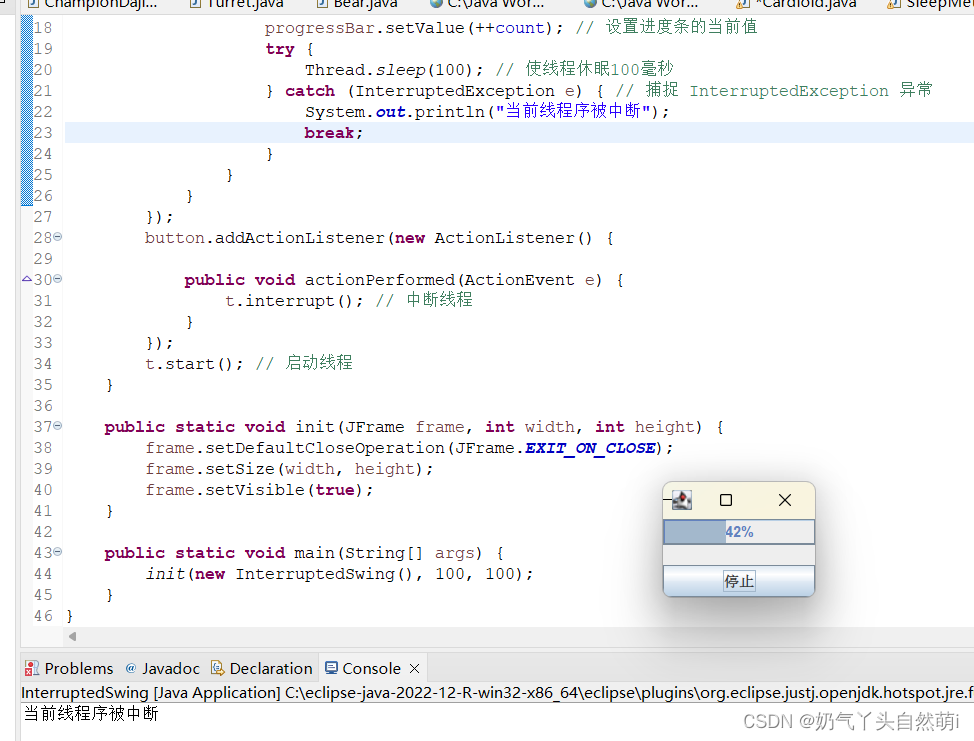
20.4.4线程的礼让
yield()方法使具有同样优先级的线程有进入可执行状态的机会,在当前线程放弃执行权会再回到就绪状态。
20.5线程的优先级
每个线程都具有各自的优先级,线程的优先级可以表明在程序中该线程的重要性,如果有会让你多线程处于就绪状态,系统会根据优先级来决定首先使用哪一个线程进入运行状态。
20.6观察不同优先级的线程执行完毕顺序
?
?
- public class PriorityTest implements Runnable {
- ?? ?String name;
- ?
- ?? ?public PriorityTest(String name) {
- ?? ??? ?this.name = name;
- ?? ?}
- ?
- ?? ?@Override
- ?? ?public void run() {
- ?? ??? ?String tmp = "";
- ?? ??? ?for (int i = 0; i < 50000; i++) {// 完成五万次字符串拼接
- ?? ??? ??? ?tmp += i;
- ?? ??? ?}
- ?? ??? ?System.out.println(name + "线程完成任务");
- ?? ?}
- ?
- ?? ?public static void main(String[] args) {
- ?? ??? ?Thread a = new Thread(new PriorityTest("A"));
- ?? ??? ?a.setPriority(1);// A线程优先级最小
- ?? ??? ?Thread b = new Thread(new PriorityTest("B"));
- ?? ??? ?b.setPriority(3);
- ?? ??? ?Thread c = new Thread(new PriorityTest("C"));
- ?? ??? ?c.setPriority(7);
- ?? ??? ?Thread d = new Thread(new PriorityTest("D"));
- ?? ??? ?d.setPriority(10);// D线程优先级最大
- ?? ??? ?
- ?? ??? ?a.start();
- ?? ??? ?b.start();
- ?? ??? ?c.start();
- ?? ??? ?d.start();
- ?? ?}
- }

20.6线程同步
在单线程程序中,每一次只能做一件事情,后面的事情需要等待前面的事情完成后才可以进行,但是如果使用多线程线程,就会发生两个线程抢占资源问题。
20.6.1线程安全
20.6.2线程同步机制
1,同步块
synchronized(Object){
}
2,同步方法
synchronized void f(){}
20.7开发线程安全的火车售票系统
?
- public class SynchronizedTest implements Runnable {
- ? ? int num = 10; // 设置当前总票数
- ?
- ? ? public void run() {
- ? ? ? ? while (true) { // 设置无限循环
- ? ? ? ? ? ? synchronized (this) { // 设置同步代码块
- ? ? ? ? ? ? ? ? if (num > 0) { // 判断当前票数是否大于0
- ? ? ? ? ? ? ? ? ? ? try {
- ? ? ? ? ? ? ? ? ? ? ? ? Thread.sleep(100); // 使当前线程休眠100毫秒
- ? ? ? ? ? ? ? ? ? ? } catch (InterruptedException e) {
- ? ? ? ? ? ? ? ? ? ? ? ? e.printStackTrace();
- ? ? ? ? ? ? ? ? ? ? }
- ? ? ? ? ? ? ? ? ? ? // 票数减1
- ? ? ? ? ? ? ? ? ? ? System.out.println(Thread.currentThread().getName() + "——票数" + num--);
- ? ? ? ? ? ? ? ? }
- ? ? ? ? ? ? }
- ? ? ? ? }
- ? ? }
- ?
- ? ? public static void main(String[] args) {
- ? ? ? ? // 实例化类对象?? ?
- ? ? ? ? SynchronizedTest t = new SynchronizedTest();
- ? ? ? ? // 以该类对象分别实例化4个线程
- ? ? ? ? Thread tA = new Thread(t, "线程一");
- ? ? ? ? Thread tB = new Thread(t, "线程二");
- ? ? ? ? Thread tC = new Thread(t, "线程三");
- ? ? ? ? Thread tD = new Thread(t, "线程四");
- ? ? ? ? tA.start(); // 分别启动线程
- ? ? ? ? tB.start();
- ? ? ? ? tC.start();
- ? ? ? ? tD.start();
- ? ? }
- }
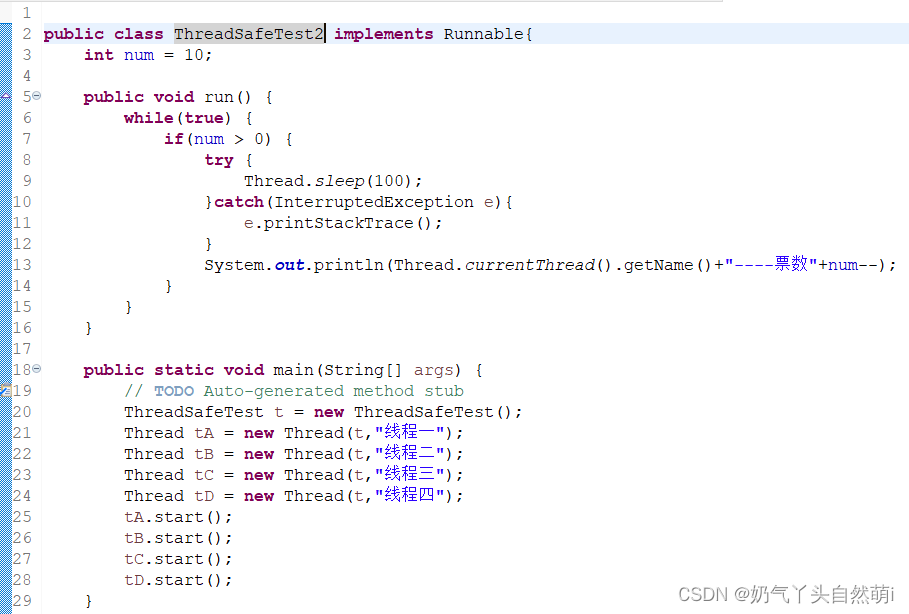
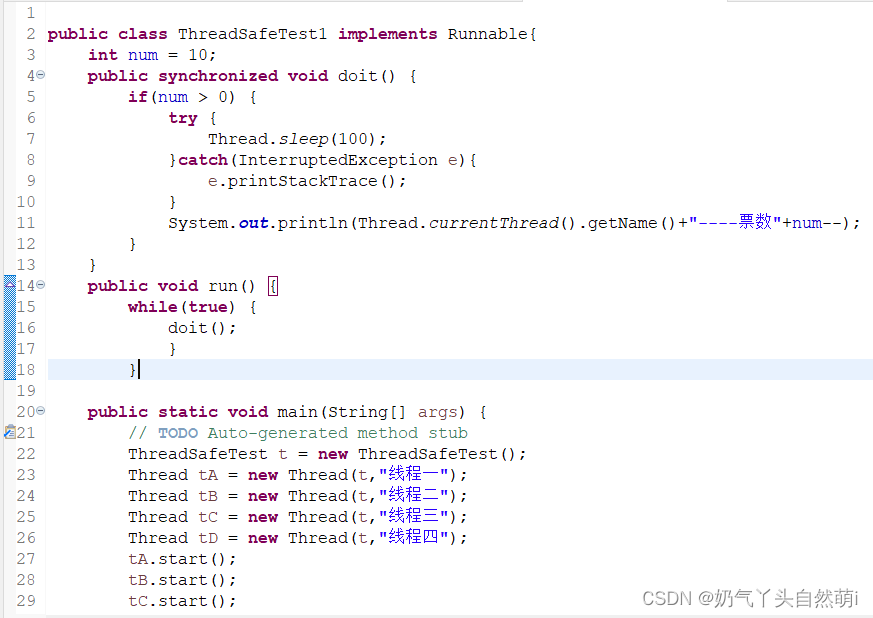 ?
?
本文来自互联网用户投稿,该文观点仅代表作者本人,不代表本站立场。本站仅提供信息存储空间服务,不拥有所有权,不承担相关法律责任。 如若内容造成侵权/违法违规/事实不符,请联系我的编程经验分享网邮箱:veading@qq.com进行投诉反馈,一经查实,立即删除!